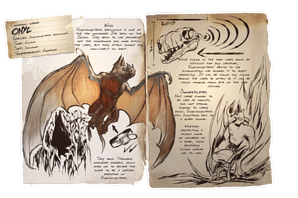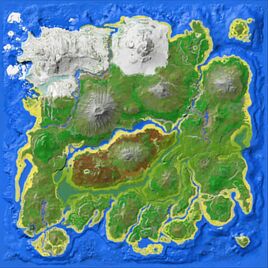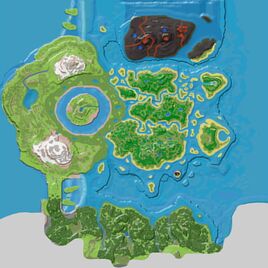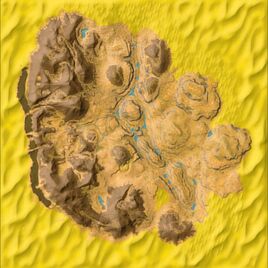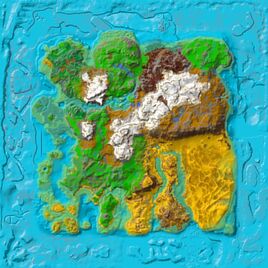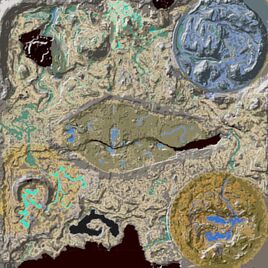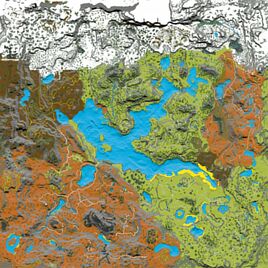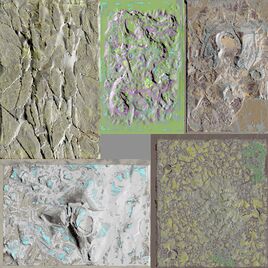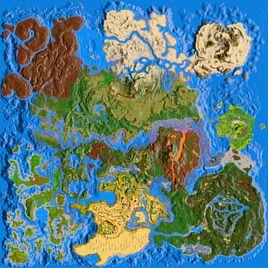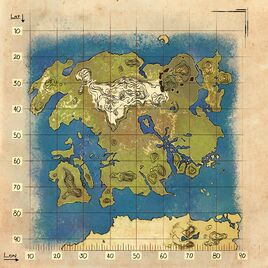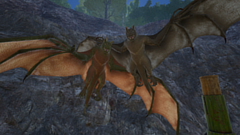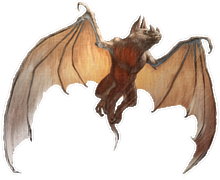Onyc
or
cheat SpawnDino "Blueprint'Blueprint'/Game/PrimalEarth/Dinos/Bat/Bat_Character_BP.Bat_Character_BP" 500 0 0 35
Variant Onyc (Gauntlet)
cheat summon Bat_Character_BP_Gauntlet_C
or
cheat SpawnDino "Blueprint'/Game/Genesis/Dinos/MissionVariants/Gauntlet/Volcanic/Bat_Character_BP_Gauntlet.Bat_Character_BP_Gauntlet'" 500 0 0 35
Variant Onyc (Retrieve)
cheat summon Bat_Character_BP_Retrieve_C
or
cheat SpawnDino "Blueprint'/Game/Genesis/Dinos/MissionVariants/Retrieve/Volcanic/Bat_Character_BP_Retrieve.Bat_Character_BP_Retrieve'" 500 0 0 35
 Aberrant Megalosaurus
Aberrant Megalosaurus Kaprosuchus
Kaprosuchus Megalosaurus
Megalosaurus Tusoteuthis
Tusoteuthis
| Esta es una traducción en progreso. El contenido y el formato de esta página pueden variar durante las próximas horas o días. |
The Onychonycteris (OH-nick-oh-NICK-teh-riss), also known as the Bat or Onyc, is a species of Mammal in ARK: Survival Evolved.
Basic Info
Dossier
Esta sección es una copia exacta de lo que Helena Walker ha escrito en sus Notas de explorador. Podrían existir discrepancias entre este texto y los detalles reales de la criatura.
- Salvaje
Onychonycteris specuncola is one of the few omnivores I've seen on the Island. They seem to live primarily off the mushrooms and moss within the caves, but they attack almost any non-insect on sight. They avoid Titanoboa whenever possible, which leads me to believe the snake to be a natural predator of Onychonycteris. While flying in the dark caves would be difficult for any creature, Onychonycteris' ability to use echolocation has allowed it to adapt perfectly. It can be found idly flying around the caves as often as it can be found hanging from bits of the cave ceilings.
- Domesticado
Not large enough to be used as mounts, and not strong enough to carry much, Onychonycteris still function well as a guard animal. Whether protecting a vacant home or members of a tribe, their relatively vicious nature has its uses.
Behavior
Bats usually fly around in caves and become aggressive when players get too close. Their pathing is currently very poor, but be careful around corners - they may attack you from the side! Due to their protocooperation with the insects inhabiting caves they can turn aggressive towards players even if they have attacked a nearby Araneomorphus or Pulmonoscorpius. When close they will slowly fly to you to attack, when hit they will fly faster and will be harder to hit. Their bite has a 10% chance of inflicting Mega Rabies.
Appearance
Bats, unlike birds, keep themselves aloft by use of long fingers which are connected with a wing membrane. Bats are good and enduring flyers, but they cannot move around in any other way. Unable to sit, bats must cling to a cave niche and remain hanging upside down to relax or to sleep. Bats are lightweight, with short and mostly brown to gray fur. They have arrowheadlike incisors, which help to part small prey animals.
Color Scheme and Regions
Esta sección muestra los colores naturales y las regiones de Onyc. Como muestra, las regiones mostradas a continuación están coloreadas de rojo sobre un modelo albino de Onyc. Los cuadrados coloreados mostrados bajo la descripción de cada región son los colores que tendrá esta criatura de forma aleatoria y dentro del rango completo de su esquema de colores. Pasa el cursor sobre un color para mostrar su nombre y su ID.
This information can be used to alter the Onyc's regions by entering cheat SetTargetDinoColor <ColorRegion> <ColorID> in the cheat console. For instance, cheat SetTargetDinoColor 0 6 would color the Onyc's "body" magenta.

Body

Claws

Membrane Shading

La región 3 no se usa
en esta criatura.

Abdomen and Legs

Wing Membrane
Drops
Base Stats and Growth
Ten en cuenta, que las estadísticas podrán variar en ARK: Survival of the Fittest, y en ARK:Mobile
| Atributos | Cantidad a nivel 1 | Aumento por cada punto | Bonif. por domesticación | ||
|---|---|---|---|---|---|
| Salvaje | Domesticado1 | Add | Mult | ||
| 250 | +50 | +5.4% | 0.07 | ||
| 100 | +10 | +10% | |||
| 150 | +15 | +10% | |||
| 1500 | +150 | +10% | |||
| 50 | +1 | +4% | |||
| 352 | +1.75 | +1.7% | 7% | 17.6% | |
| 100% | N/A3 | +1% | |||
| 200 | +12 | N/A4 | 0.5 | ||
1Los porcentajes se basan en el valor de la estadística al momento de ser domesticada (es decir, después de aplicarse la efectividad de tameo.)
2Aquí, se muestra el Daño base en bruto, en lugar de mediante porcentajes.
3Las criaturas salvajes no aumentarán su Velocidad de Movimiento al subir de nivel.
4La Inconsciencia aumenta con los niveles, pero no puede ser subida manualmente una vez ha sido domesticada.
- Para ver una comparación de todas las estadísticas de las criaturas, consulta las estadísticas base de las criaturas.
- Para una explicación de cómo se calcula la subida de nivel, comprueba los cálculos de estadísticas para las criaturas.
| Tipo de movimiento | Velocidad base | Corriendo | Energía usada | |
|---|---|---|---|---|
| Salvaje | Domesticado | |||
| Caminando | 350 | 577.5 | 577.5 | 5 |
| Nadando | 240 | N/A | N/A | N/A |
| Volando | 350 | 577.5 | 577.5 | 3 |
- Estas son las velocidades base con un 100 % de Velocidad de Movimiento
- Para una comparación de todas las velocidades de movimiento, consulta Velocidad base de criaturas
| Stamina Cost | Attack Range | Description | |||||||||||
|---|---|---|---|---|---|---|---|---|---|---|---|---|---|
| Base | Minimum | Activation | |||||||||||
Aumento de estadísticas al subir nivel en estado salvaje
Escribe los valores de la criatura salvaje para revisar en que estadísticas sobresale más. Los valores marcados con verde en una criatura de alto nivel son muy buenos para la crianza/reproducción. Si ya has domesticado una criatura, puedes intentar recuperar la información que tenía cuando era salvaje con la siguiente herramienta: ARK Stats Extractor.
Nota: después de que la criatura sea domesticada, conseguirá algunas bonificaciones a sus estadísticas dependiendo de la efectividad del domesticado. Esto dificulta el obtener los niveles precisos de una criatura domesticada, por lo que esta calculadora te ayudará mucho, ya que está pensada para dinosaurios salvajes únicamente. Con ella, podrás tener una idea sobre la distribución de las estadísticas de una criatura.
Taming
The Onyc is tamed non-violently, rather than through the use of tranquilizers, and requires a player level of 65 to feed. Since it is a naturally aggressive creature, you must first apply ![]() Bug Repellant to yourself in order to keep it from attacking you on sight. The Bat will not be tameable if it is trying to attack another creature or is feeding on a corpse, so you must remove any such distractions from the area, or lure the Bat to a more secluded area.
Bug Repellant to yourself in order to keep it from attacking you on sight. The Bat will not be tameable if it is trying to attack another creature or is feeding on a corpse, so you must remove any such distractions from the area, or lure the Bat to a more secluded area.
Once you have the repellent applied and distractions dealt with, place the food you wish to feed it in the right-most slot of your hotbar. Then, carefully approach the Bat until the button prompt to feed it appears - it will eat the piece of food you give it and a taming bar will appear. You must then wait until it becomes hungry enough to be fed again, and repeat the process.
If you accidentally get too close and touch the Bat, it will become aggressive and attack, despite the repellant. In order to continue taming it, you must get far enough away for it to lose interest in you. A Ghillie Suit can be used as a substitute for repellant, but you will need to be prone to get close enough to tame it, leaving you vulnerable to attacks.
| Feeding Interval | Time | ||
|---|---|---|---|
| 9 | 03:22 | 0:27:01 | |
| 11 | 03:18 | 0:33:01 | |
| 21 | 03:08 | 1:02:56 | |
| 31 | 03:06 | 1:33:01 | |
| Feeding Interval | Time | ||
|---|---|---|---|
| 16 | 03:12 | 0:48:01 | |
| 19 | 03:10 | 0:57:01 | |
| 38 | 03:04 | 1:53:53 | |
| 57 | 03:03 | 2:51:01 | |
| Feeding Interval | Time | ||
|---|---|---|---|
| 23 | 03:08 | 1:09:01 | |
| 28 | 03:06 | 1:24:01 | |
| 56 | 03:03 | 2:47:49 | |
| 84 | 03:02 | 4:12:01 | |
| Feeding Interval | Time | ||
|---|---|---|---|
| 30 | 03:06 | 1:30:01 | |
| 37 | 03:05 | 1:51:01 | |
| 74 | 03:02 | 3:41:46 | |
| 111 | 03:01 | 5:33:01 | |
| Feeding Interval | Time | ||
|---|---|---|---|
| 37 | 03:05 | 1:51:01 | |
| 46 | 03:04 | 2:18:01 | |
| 92 | 03:01 | 4:35:42 | |
| 138 | 03:01 | 6:54:01 | |
| Feeding Interval | Time | ||
|---|---|---|---|
| 44 | 03:04 | 2:12:01 | |
| 55 | 03:03 | 2:45:01 | |
| 110 | 03:01 | 5:29:39 | |
| 165 | 03:01 | 8:15:01 | |
Tenga en cuenta que los valores son para los casos óptimos, siempre llevar suministros adicionales!
Para obtener un valor más aproximado de los recursos necesarios, prueba Calculadoras externas de doma.
Preferred Food
Combat
This section describes how to fight against the Onyc.
General
Onyc's appear in caves in huge numbers and can shred even flak armor with ease. Wearing hide armor is quite recommended so you can repair your armor on the fly while still providing protection.
Strategy
In the close-quarters of the cave you will likely only get 1-2 shots off before the Onyc is on top of you so you will rely heavily on melee to kill them. Concentrate fire with allies and evade melee as much as possible. It should be noted that their damage rapidly compounds massive armor damage and the faster you can kill them the better.
Weaponry
Close-range weapons are necessary. A shotgun is expensive but guarantees victory against all but the largest swarms. A pike can prove capable of piercing many Onycs at once, and a shotgun will obliterate them once they are close.
Dangers
If you are caught by large numbers of bats without armor they will make short work of you. They also synergize extraordinarily well with other cave creatures that specialize in locking you down with tranquilizing venom and web attacks. Becoming immobilized by other creatures in the cave will render you susceptible to the Onyc's armor-rending attacks. Keep your armor repaired, and bring materials to repair it on-site if possible (remember you can skin Onycs, Sarcos, and Titanoboas for necessary hide but typically cannot gather fiber where bats are found).
In Patch v261.0 Onycs gained a 10% chance to inflict ![]() Mega Rabies on hit. This makes getting hit much more dangerous to unprepared survivors. Consider bringing Lesser Antidote when exploring areas that Onyc are in.
Mega Rabies on hit. This makes getting hit much more dangerous to unprepared survivors. Consider bringing Lesser Antidote when exploring areas that Onyc are in.
Weakness
Don't be afraid to retreat and hit-and-run large clumps to death as the Onyc is surprisingly bad at chasing. Bringing mounts is extremely effective as even a lowly Dimorphodon can prove a necessary distraction to deal lethal damage or, in numbers, fight the bats easily on their own.
Utility
Roles
- Armor Destroyer: Even in late-game fights that are usually won by Rexs and Spinos, the Onyc's unique ability to devastate armor makes it remarkably dangerous to players. (Level up Damage and Health)
- Guard: Capable of protecting your home from raiders by simple virtue of devouring them and their armor the second they come in contact with the enemy. (Level Damage and Health)
- Hunter: Intermixed with Dimorphodon it can devastate enemies when deployed offensively in large swarms versus players. (Level up Damage and Health)
- Usurper: The ability to ruin a player's armor easily is a skill that, employed correctly, can allow a low level player who has obtained one to tactically use this power to eliminate a higher-level player. A nighttime ambush on an oblivious survivor can result in the higher-level player losing their armor while the player works to kill them. This method can be made simpler by utilizing an Arthropleura, which also quickly destroys an enemy's armor.
- Damage: It's attack has 35 base damage, which is at the same level of medium carnivores such as Carno and Sarco.
- Swarmers: A swarm of tamed bats can dismember opponent survivors in a mere seconds by shredding their armor first, and deals considerable damage to them at the same time.
- Aerial Attack:
- Combatant:
Collectibles
- No information available.
Efficiency
- No information available.
Bugs/Glitches
- Since the release of Aberration, the Onyc icon has been improperly replaced by the
 Seeker icon, and vice versa.
Seeker icon, and vice versa.
Notes/Trivia
Para más información sobre esta criatura en el mundo real, consulta el artículo de Wikipedia asociado
- When using the whistle command for landing fliers on the Onyc, they appear to do a back flip, putting their feet up to grab. Because of this, it seems possible that they will be able to "land" and hang from ceilings in a future update.
- As of March 2020, nearly 5 whole years since the game launched in early access, the inability for the Onyc to land has still not been addressed and most likely never will be by the devs, as the Onyc is a creature of lower importance/priority to most players and developers of the game.
- 3-5 Onychonycteris can easily shred through even the best armor, so it is advised not to wear valuable armor when exploring caves, as they are usually everywhere and in high quantities.
- The Onyc can spread
 Mega Rabies to a survivor even when mounted, as they can also focus attacks on the rider like that of the
Mega Rabies to a survivor even when mounted, as they can also focus attacks on the rider like that of the  Dimorphodon and
Dimorphodon and  Microraptor.
Microraptor. - The fact they can spread Mega Rabies is a reference to how the Vampire bats (Desmodontinae) use their saliva to prevent wounds from clotting up so they can eat at their leisure for roughly 30 minutes.
- The generic name Onychonycteris means "clawed bat" in Greek. The species name specuncola appears to be an improper combination of Latin specus "cave" and -cola "dweller" (thus "cave dweller"), possibly via confusing/conflating specus with spelunca (from Greek σπῆλυγξ spêlunx), which also means "cave"; the correct form would be either specicola or speluncicola.
- The bat in game is much larger than a real Onychonycteris, which actually wasn't very big with only around a 50 cm wingspan.
- Real life Onychonycteris were incapable of the echolocation of modern bats.
- Since the release of Aberration, the Onyc icon has been improperly replaced by the
 Seeker icon. This was fixed in 316.18.
Seeker icon. This was fixed in 316.18. - As the Onyc cannot land or swim, they cannot be cloned using the
 Tek Cloning Chamber and cannot be teleported using the
Tek Cloning Chamber and cannot be teleported using the  Tek Teleporter unless a
Tek Teleporter unless a  Megalosaurus is used to grab and "ground" the Onyc.
Megalosaurus is used to grab and "ground" the Onyc. - Cannot leave the northeast cave on The Island if tamed there unless a
 Cryopod is used.
Cryopod is used. - If one looks closely at the wings of an Onyc, a flaw in the model can be spotted as there are 2 big holes in the membrane of the wing that are opened and shut with every wing beat.
- This has since been fixed as of December 2019, though it is unknown which patch it came in.
- According Helena's notes Onycs has been seen eating mushrooms and moss growing in the caves. However, in the game survivors can't gather the mushrooms or moss that grow in the caves.
- Real bats are social animals that live in colonies however Ark's Onyc doesn't have this behavior that real bats have. Rather, they merely congregate in large groups, usually for the reason of preying upon unlucky survivors.
- Despite the dossier stating they're fearful of
 Titanoboa, they show no signs of fear in game and in fact will typically be found near them.
Titanoboa, they show no signs of fear in game and in fact will typically be found near them.
- This was probably an originally planned mechanic that would make the Titanoboa the main predator of the Onyc, though this has never been seen to come to fruition and probably for good reason, as both creatures would kill each other constantly and inevitably would attack other creatures by accident, instead of attacking the player. This would make caving WAY easier, as all one has to do is pit the Titanoboa and Onyc (and most likely other creatures would get involved) against each other and wait for the battle to end and pick off the survivors.
- Prior to 316.19, Onyc gender was unrecognizable, only seen as a white name as opposed to pink or blue names representing the gender. They could not be bred because of this.
- The Onyc is incapable of moving on the ground. All known bats in real life, however, are capable of crawling.
Changelog
| Patch | Changes |
|---|---|
| 221.0 | The Onyc is now tameable through passive means. This change came alongside the first ARK: Fear Evolved event, which also made the |
| 223.0 | Added the creature "fur" pass to make hair and feathers look better |
| 261.0 |
|
| 309.4 | Reduced the amount of Onyc spawns within the Volcano biome's Volcanic Cave in Genesis: Part 1 |
| 316.19 TLC 3 | Onyc are now breedable |
Gallery
References
| Criaturas | ||||||||||||||||||||||||||||||||||||||||||||||||
|---|---|---|---|---|---|---|---|---|---|---|---|---|---|---|---|---|---|---|---|---|---|---|---|---|---|---|---|---|---|---|---|---|---|---|---|---|---|---|---|---|---|---|---|---|---|---|---|---|
| ||||||||||||||||||||||||||||||||||||||||||||||||
- Pages using DynamicPageList3 dplvar parser function
- Pages using Tabber parser tag
- Páginas con errores en secuencias de órdenes
- Mammals
- Omnivores
- Aggressive creatures
- Creatures released in 2015
- Creatures released in v729
- Creatures released in v501
- Creatures released in v599
- Creatures released in v1
- Criaturas domesticables
- Breedable creatures
- Criaturas que son inmunes a inconsciencia
- Gestation
- Criaturas
- Traducción en progreso
- Imagen no encontrada
- Flyers
- Falta traducción: TH


